 |
 |
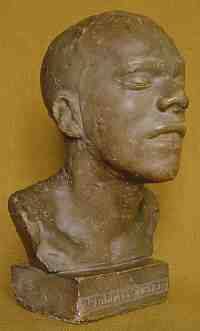
|
Corder's bust
Moyse's Hall holds a copy of William Corder's death bust, now one of Bury's star attractions. It was kept for many years at the old West Suffolk Hospital. Offered to the museum, it was rejected by the then curator as "too macabre" and thrown away. A passer-by rescued it from the rubbish tip. He offered it to a later, less squeamish, curator, who gladly accepted.
People often comment on the bust's apparently negroid features. These are a side effect of the hanging. Corder's head was engorged with blood, as the prominent veins suggest and the autopsy report confirms. As far as we know, Corder was of Suffolk stock.
The bust was made by Mr. Child of Bungay, a well-known Suffolk printer who also had a talent for making death masks and busts. He sent a copy to a noted phrenologist, Dr. Spurzheim, who read its bumps in order to understand Corder's character. The report, unlike the pseudo-science of phrenology, still survives.
| |
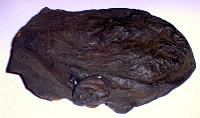
|
Corder's scalp Corder's corpse was dissected at the West Suffolk Hospital. The surgeon, George Creed, kept and preserved the scalp, with the right ear attached. He also retained and tanned a part of the skin. Stubble can still be seen on the scalp, giving rise to tales that Corder's hair grew mysteriously after his death. The truth is more prosaic. After shaving, a small length of the hair shaft remained below the skin. The scalp shrank during the tanning process, but the hair was not affected and protruded above the surface.
| |
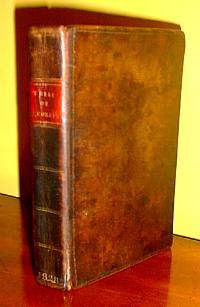 |
The book bound in Corder's skin Visitors to the museum often ask to see the bible bound in Corder's skin. We don't have one - but his skin was used to bind a book. It is a copy of Curtis's account of the murder, and once belonged to George Creed, the surgeon who conducted the dissection. Creed inscribed it thus: "The Binding of this book is the skin of the Murderer William Corder taken from his body and tanned by myself in the year 1828. George Creed Surgeon to the Suffolk Hospital" The book also contains a handwritten anecdote which shows the public interest in the story. It reads ' "Is execution done on Cawder (sic)?" Macbeth. / Drury Lane Theatre : Night of the Execution of W. Corder .. / When this line was repeated, a man from the Gallery exclaimed. / "Yes! - He was hung this morning at Bury" / Anecdote told to the Rev. J.M. Bellew (?) [name unclear] / by William Charles Macready / Bury - April 4 18(4?)5 (date unclear) ' Maria Marten's irons The museum has two small flat irons thought to have belonged to Maria Marten. Did she use these very items to iron her clothes before she left home for the last time?
| |
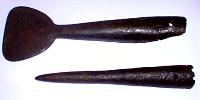
|
Mole spud This is said to have belonged to Thomas Marten, Maria's father. Probing the floor of the Red Barn with the mole spud, he found the patch of loose earth where the body was buried. Only the metal parts survive. An essential tool for a molecatcher, the molespud consisted of a wooden shaft with a metal point at one end and a small metal spade, about 3inches (8cm) wide at the other. It was used to find mole runs and dig out moles.
| |
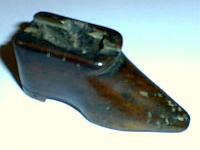
|
Relic of the Red Barn Such was the notoriety of the murder that even before the trial, sightseers were making their way to Polstead in droves. This was no mean achievement, since there were few good roads and no railways. Most visited the Red Barn. Many of them broke off pieces for souvenirs. This piece, turned into a shoe-shaped snuff box, is a rare survival. A drawing of the Red Barn printed in the 'Essex Herald' at the time of the trial shows most of the wooden cladding missing from the lower walls. The following extract from The Times tells of the exploits of the souvenir hunters.
| |
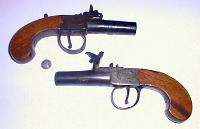
|
Pistols For some reason Corder did not dispose of the murder weapon. Constable Lea reported that he found a pair of pistols made by Harcourt of Ipswich in Corder's house at the time of the arrest. They were in a reticule (a small bag) which had belonged to Maria. The pistols were used as exhibits at the trial. In order to prevent anyone from grabbing and using them in court, the hammers were crudely broken off. For those interested in firearms, they are percussion boxlock pocket pistols made by Harcourt of Ipswich. They have round screw barrels 1 9/16ths inches long, Birmingham proof, .460 calibre, with plain slab butts, marked HARCOURT on the left side of the action and IPSWICH on the right. Overall length is 6 1/4 inches. One has been strongly marked by twisting in a vice and the tip of the frizzen has been chipped. This pistol has a sliding safety catch to the rear of the hammer, a feature not present on the other, though its butt has been recessed to admit one. The pistols' 'top-hat' ignition system is of particular interest. It dates to about 1825 and is rarely found on pistols. A hinged cover descends to hold a 'top-hat' shaped cap in place on the nipple. At first glance the pistols appear to be conversions. The frizzen has been retained to make up the hinged cover, and the overall appearance is that of a flintlock. However, the nipple lies too far back to have been placed in the vent of a flinter and it is quite likely that the pistols were made with the latest ignition system but used parts originally intended for flintlock weapons. John Harcourt of Ipswich was in business from 1792-1839. He died at the age of 79 in 1846. It is not known whether he was related to the Sudbury gunmaker Henry Harcourt. Corder told the arresting constable that he had bought the pistols when he was ten years old. The Coroner observed that the detonating principle was a much more recent invention. Much was made about the pistols at the trial. Evidence was given by Henry Harcourt, the Sudbury gunmaker (in business from before 1825 until 1868). He related that Corder took a pair of percussion pistols to his premises in Sudbury for repair in February 1827, but was not able to say if the court exhibits were the same ones. He stated that percussion pistols had been in vogue for seven or eight years. During the trial Corder maintained that Maria had committed suicide with one of his pistols. She knew he had them, and that he kept them loaded in his bedroom. She had been with him when he collected them from Henry Harcourt's, a fact which Harcourt's evidence helped corroborate. Maria's stepmother testified that she had seen Corder snapping his pistols into the fireplace at the Martens' cottage, and that on the day Maria left home Corder had his pistols with him and that they were loaded. The fatal bullet was not in the body, nor could it be found in the grave or the barn. A bullet from the reticule fitted the wound. In his statement, Lawton, the surgeon who had first examined the body said "a pistol ball had entered the neck of the deceased about the jugular, and that it took an oblique direction to the eye on the opposite side of the head." He then produced Maria's head to the court's great consternation. A second surgeon, Nairn later wrote that the wound in the face would not have been sufficient to cause death, and that he was fully convinced that "more than the pistol was used in despatching the unfortunate girl." Corder was reputedly a good shot, but very short sighted. With their short barrels, the pistols would have made them low-powered and inefficient. To hit anyone with them it would have been necessary to fire point-blank. This could have happened had there been a struggle as Corder later claimed. It could also have been a deliberate act.
| |
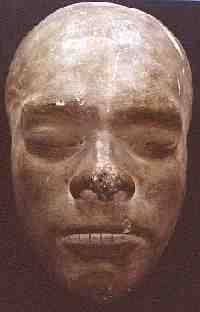
|
Death mask The death mask in Moyse's Hall is a copy, made in 1945, of an original in Norwich Castle Museum. The mould for the original was made by a Mr. Mazzotti of Cambridge at the same time that Child took moulds of Corder's head for the bust. "John Bull" "John Bull" was a popular periodical. The issue for April 27th 1828 carries two reports of Corder's arrest, and shows the depth of public interest even at this early stage in the story. Copies of 'The Times' The museum is lucky to have copies of most of the issues of the "Times" which cover the Red Barn story.
| |
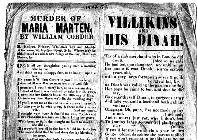
|
Broadsheets After the trial and execution, several publishers brought out broadsheets which sold at a penny (1d) each, to cash in on the murder when public interest was at its greatest. They tell the story in varying amounts of detail. One or two even include a poem, purporting to be by Corder himself, warning others not to imitate his deed and thereby avoid his fate. Large numbers, perhaps around a million, were sold.
| |
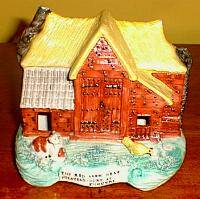
|
Red Barn Staffordshire pottery model The Staffordshire potteries produced souvenirs for all occasions. The Red Barn Murder was no exception. Model Red Barns, even miniatures of Corder and Maria were eagerly bought. "Corder's Sword" Prosecutors at the trial tried to prove that Corder had stabbed Maria. They showed that he owned a short sword, which he had had sharpened in Hadleigh shortly before the murder. Corder consistently denied that he had stabbed Maria. For many years the museum an item labelled "William Corder's Sword" was displayed in Moyse's Hall, alongside its sheath. Stains on the blade were even claimed to be her blood. Closer examination showed that the "sword" is a carving knife and the stains are rust, not blood. The sheath, from an entirely different knife, does not even fit properly. Since its authenticity is very doubtful, the sword is no longer on show.
|
| Go to Red Barn Homepage | Return to First topic - Introduction to the Red Barn |
Created 9 July 2001 by St Edmundsbury Museums Staff Last updated 27 December 2006 | Go to Main Home Page |